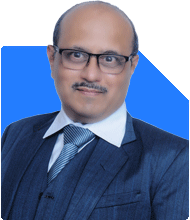Ramalingam Kalirajan |10891 Answers |Ask -Follow
Mutual Funds, Financial Planning Expert - Answered on Oct 01, 2024
He has an MBA in finance from the University of Madras and is a certified financial planner.
He is the director and chief financial planner at Holistic Investment, a Chennai-based firm that offers financial planning and wealth management advice.... more

Hi Sir, I have around 4 CR which will be available to me by March 2025.I wanted to do investment of that 4 CR so that I can generate enough funds (roughly 2 lakh) per month. I dont want some risky investment where I might loose money. I am OK with a fund manager who can manage that. I am strongly against mutual funds as they dont give actual return what they earn from our funds. Please advise.
Generating Rs 2 Lakh Monthly Income
Your goal of generating Rs 2 lakh per month translates to Rs 24 lakh annually, which is 6% of Rs 4 crore. Achieving this in a low-risk manner is possible, but it requires careful planning. Your preference for low risk indicates that capital preservation is a priority, and you are open to engaging a fund manager for this purpose.
Here are some options that could meet your requirements.
Safe Investment Options
1. Fixed Deposits (FDs)
Bank FDs are one of the safest investment options in India. Many banks offer senior citizen fixed deposit schemes with slightly higher interest rates.
Though returns from FDs range between 6-7%, this might be lower than your target. However, FDs ensure safety of your principal amount, which is important for low-risk investors.
2. Senior Citizen Savings Scheme (SCSS)
The Senior Citizen Savings Scheme is a government-backed scheme. It is ideal for investors above 60 years old who seek regular income. The current interest rate is around 8%, but it may fluctuate based on government decisions.
The scheme has a tenure of 5 years, which can be extended by another 3 years. You can invest a portion of your Rs 4 crore in SCSS, subject to its upper limit.
3. Post Office Monthly Income Scheme (POMIS)
POMIS is a government-backed scheme, offering a guaranteed monthly income. The returns are not high, but it offers security and peace of mind. Interest rates are around 6.6% to 7%.
The maximum investment limit per individual is Rs 9 lakh, so you can consider spreading the amount across multiple family members.
4. Debt Instruments
You can explore corporate bonds or non-convertible debentures (NCDs) from reputed companies. These offer better returns than bank FDs, ranging between 7-9%, and are relatively safe when invested in top-rated companies.
Government bonds are another option, where you can lock in returns for the long term. Though they may offer lower returns than corporate bonds, they come with low risk.
5. Conservative Hybrid Funds
Although you have reservations about mutual funds, conservative hybrid funds may align with your risk profile. These funds invest predominantly in debt instruments, ensuring stability, and a small portion in equities for growth.
Returns from such funds generally range between 7-9%, and they provide regular dividend payouts. The active fund management ensures risk is minimised, and you can achieve better returns than traditional FDs.
6. RBI Floating Rate Bonds
RBI Floating Rate Savings Bonds are considered very safe as they are backed by the government. These bonds currently offer interest rates around 7-8%.
The interest is paid semi-annually, providing a steady source of income. The rates are linked to prevailing government securities rates, making them slightly more flexible.
7. SWP in Debt Mutual Funds
While you are not in favour of mutual funds, a Systematic Withdrawal Plan (SWP) in debt funds could be a good fit. It ensures regular income while keeping risk low since these funds invest mainly in government securities and corporate bonds.
Debt funds also offer tax efficiency if held for more than three years, as long-term capital gains are taxed at a lower rate than interest income.
Role of Certified Financial Planner
You have mentioned that you are comfortable with a fund manager handling your investments. A Certified Financial Planner (CFP) can help design a customised portfolio tailored to your risk appetite. The CFP will manage your investments actively, ensuring that the balance between income generation and capital preservation is maintained.
The advantage of having a CFP manage your investments is that they continuously assess the market conditions. They can recommend switching to better-performing options if necessary.
CFPs also focus on tax efficiency, ensuring that you keep more of your earnings rather than losing them to taxes.
Tax Efficiency
Given your preference for safety and regular income, tax-efficient investments are crucial. Interest income from FDs, bonds, or other fixed-income instruments is taxable at your income tax slab rate. However, certain investment options like debt mutual funds can offer more tax-efficient returns.
SWP in Debt Funds: In an SWP, only the portion that represents capital gains is taxed, making it more tax-efficient than receiving the entire amount as interest income.
Achieving Balance Between Safety and Returns
To meet your goal of generating Rs 2 lakh per month, your investments should ideally be spread across various low-risk instruments. Here is a potential approach:
Fixed Deposits and SCSS: Allocate a portion to these to ensure safety and guaranteed returns.
Corporate Bonds and Debt Funds: These can provide higher returns than traditional FDs without taking too much risk.
Post Office Monthly Income Scheme and RBI Bonds: Allocate another portion here to diversify across low-risk government-backed schemes.
Systematic Withdrawal Plan (SWP): Set up an SWP in conservative hybrid or debt mutual funds to provide regular monthly income with tax-efficient withdrawals.
By balancing your portfolio between these safe options, you can aim to achieve both capital preservation and regular income.
Final Insights
You are rightly focused on maintaining the safety of your principal amount while generating a regular income of Rs 2 lakh per month. Based on your preferences, a combination of fixed deposits, SCSS, bonds, and conservative debt mutual funds will help you meet your goals.
While mutual funds may not be your first choice, debt funds with an SWP option can offer a tax-efficient alternative with minimal risk. Working with a Certified Financial Planner (CFP) will ensure that your investments are professionally managed, keeping your financial objectives in mind.
Best Regards,
K. Ramalingam, MBA, CFP,
Chief Financial Planner,
www.holisticinvestment.in
https://www.youtube.com/@HolisticInvestment
You may like to see similar questions and answers below
Ramalingam Kalirajan |10891 Answers |Ask -Follow
Mutual Funds, Financial Planning Expert - Answered on Apr 30, 2024
Ramalingam Kalirajan |10891 Answers |Ask -Follow
Mutual Funds, Financial Planning Expert - Answered on Aug 16, 2024
Nitin Narkhede | Answer |Ask -Follow
MF, PF Expert - Answered on Oct 10, 2024
Ramalingam Kalirajan |10891 Answers |Ask -Follow
Mutual Funds, Financial Planning Expert - Answered on Oct 14, 2024
Ramalingam Kalirajan |10891 Answers |Ask -Follow
Mutual Funds, Financial Planning Expert - Answered on Dec 23, 2024
Radheshyam Zanwar |6746 Answers |Ask -Follow
MHT-CET, IIT-JEE, NEET-UG Expert - Answered on Dec 15, 2025
Ramalingam Kalirajan |10891 Answers |Ask -Follow
Mutual Funds, Financial Planning Expert - Answered on Dec 15, 2025
Ramalingam Kalirajan |10891 Answers |Ask -Follow
Mutual Funds, Financial Planning Expert - Answered on Dec 15, 2025
Ramalingam Kalirajan |10891 Answers |Ask -Follow
Mutual Funds, Financial Planning Expert - Answered on Dec 15, 2025
Samraat Jadhav |2508 Answers |Ask -Follow
Stock Market Expert - Answered on Dec 15, 2025
Ramalingam Kalirajan |10891 Answers |Ask -Follow
Mutual Funds, Financial Planning Expert - Answered on Dec 15, 2025
Reetika Sharma |425 Answers |Ask -Follow
Financial Planner, MF and Insurance Expert - Answered on Dec 15, 2025
Radheshyam Zanwar |6746 Answers |Ask -Follow
MHT-CET, IIT-JEE, NEET-UG Expert - Answered on Dec 15, 2025
Reetika Sharma |425 Answers |Ask -Follow
Financial Planner, MF and Insurance Expert - Answered on Dec 15, 2025
Ramalingam Kalirajan |10891 Answers |Ask -Follow
Mutual Funds, Financial Planning Expert - Answered on Dec 15, 2025

























.jpg)